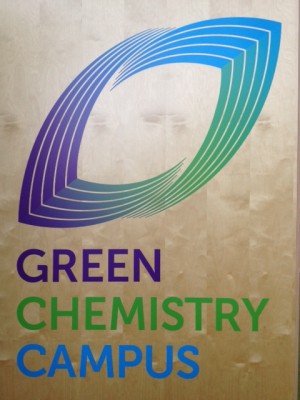The Bergen op Zoom region, in the Southwestern part of the Netherlands, is the centre of the new green economy – for those who did not know yet. They have it all: strong agrofood industries, a strong agricultural sector with many side streams, ambitious and international chemical companies, a thriving logistical sector and many good transport links. The Green Chemistry Campus, established last year at the site of chemical giant SABIC, will develop the green economy with powerful innovations.
 Open innovation
Open innovation
The Green Chemistry Campus is one of three COCIs in the Netherlands: Centres for Open Chemical Innovation. Open innovation is a buzz word. Participating companies do not shield their research from each other, but try to support each other. In an innovative community, developments go faster. Transition guru Jan Rotmans judges the Green Chemistry Campus to be ‘a biobased pearl’, because he sees this philosophy actually put into practice. SABIC opened up its lab for smaller companies (now some fourteen), but stays at a distance. Participants can use the large companies’ facilities (energy, analytical laboratory, permits etc.), but big brother does not peep across their shoulders. However, it is quite keen on scaling up good innovations. SABIC’s main area of interest is to secure its resource base by expanding it to renewable feedstock.
Partners and founders of the Green Chemistry Campus are North Brabant province, the municipality of Bergen op Zoom, and the regional development agency REWIN West-Brabant; the latter is in charge of management and of acquiring new participants.
Aromatics
One of the new activities is the Shared Research Centre Biobased Aromatics, started in March 2013. In view of the shortages expected in aromatics at the world market, this centre will investigate the pathways from agricultural waste streams to aromatic molecules. They have high ambitions: the target is to become one of the top centres in the world in this area within 5 years. The Centre has three founders: the Green Chemistry Campus, Dutch TNO and Flemish VITO. Other interested companies may join, and so might other research institutes with specific and required know-how.
‘TNO and VITO have a long history of cooperation,’ says Green Chemistry Campus’s Willem Sederel, ‘and with just these participants, we can make good progress. Participants, location and subject fit together nicely, and lend themselves to further development. For instance, TNO working closely together with Cosun is very knowledgeable in the classical chemical C5 sugar pathway. Lignin as a resource is rather VITO’s subject; they can fit into the strength of Ghent University’s biomass research. Coupled to the strong chemical sector of the Canal Area (Ghent-Terneuzen) and its region, we have optimal conditions for swift further developments.’
Avans University of Applied Sciences is a strong and ambitious educational partner to the Green Chemistry Campus. The campus seems to be excellently positioned to take the green economy to a higher level quickly.
